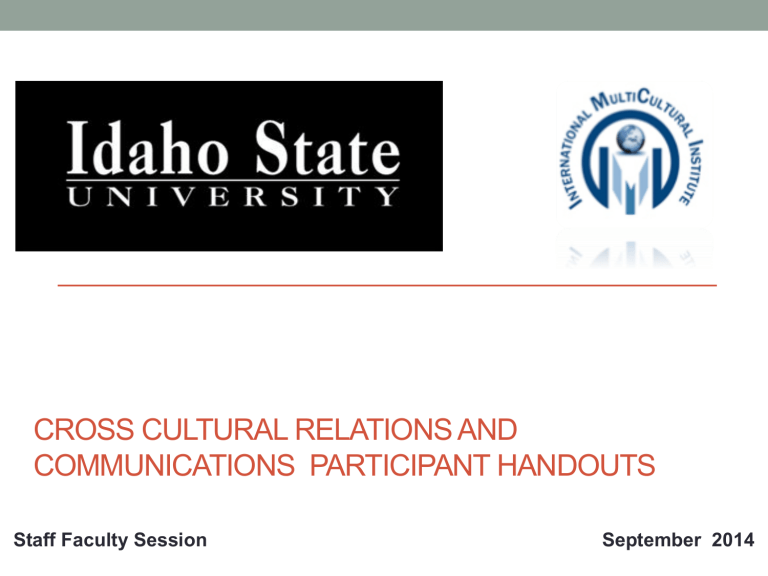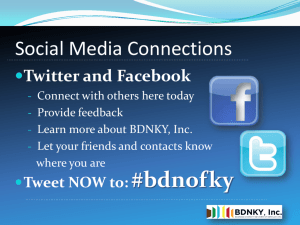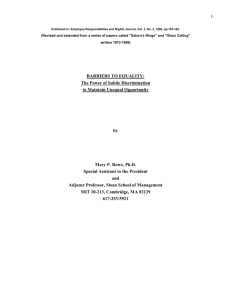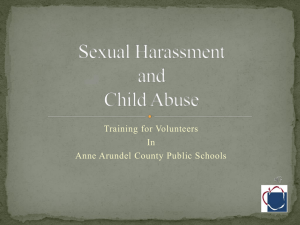Staff Faculty Session September 2014

CROSS CULTURAL RELATIONS AND
COMMUNICATIONS PARTICIPANT HANDOUTS
Staff Faculty Session September 2014
CROSS CULTURAL RELATIONS AND
COMMUNICATIONS
Faculty Session September 2014
Workshop Objectives:
Identify how aspects of your cultural identity may give rise to some unconscious biases
Understand the meaning of culture, stereotypes and generalizations
Learn about your cultural “hot buttons” and how to respond to those of others in the group
Commit to taking actions to increase your crosscultural understanding, competence, and humility
Visualization Exercises: Imagine…
• Imagine that you have just arrived at ISU from country “X” or US community “X”.
• Consider how you experienced your first “different people” encounters.
Describe your first impressions of food, smells, ISU campus; and meeting faculty, staff and your roommate.
How is the classroom experience different here vs. where you came from?
• Take a few minutes to
• What remains your greatest challenge?
Understanding Culture
One’s own culture provides the “lens” through which we view the world; the “logic” by which we order it; the “grammar” by which it makes sense.
Avruch and Black, anthropologists
Cultures Are….
Invisible to its members
Much is below the surface
Dynamic
Heterogeneous
Often overlap and intersect, e.g., university and national
Individuals within cultures differ
Rate Yourself! Cultural Humility,
Awareness and Competence
Cultural Humility : Cultural
Competency: a commitment to self-evaluation and the development of an openness and sensitivity to the cultural identities of people from other groups.
effectively operating in different cultural contexts through the development of specific skills.
1 4 5 2 3
Cultural Awareness/
Knowledge: familiarization based on training about or experience with certain cultural characteristics, history, values, belief systems, and behaviors of the members of another group.
The Biggest Practical Challenges
For Cross-Cultural Teams
Use of Time
Attitude towards deadlines, timelines, etc.
Language
Power Distance
Attitude towards hierarchy/authority
Loyalty
Endless Debates
Consensus vs. Action;
Who decides when to stop
Work/Life
Balance
Work hours, flexibility, sacrifice
Trouble with accents, fluency, meaning
Micro-managing
Towards company, region, division, compatriots, or self?
Feedback Over-analyzing
Leadership styles, individual autonomy
Truth or diplomacy?
Group or personal?
Decisions/No Decisions
How do we decide?
What constitutes commitment?
Theory or fact?
Attitude towards risk
Sources: FWI, Hall, TMA World
Worldview is…
“Worldview” is: the comprehensive set of beliefs, knowledge, values, assumptions, attitudes, and opinions that serve as a lens through which a particular social group sees, interprets, and makes sense of the world in which it lives.
Culture Shock: Why?
Three basic explanations:
• Loss of familiar cues
• Breakdown of interpersonal communication
• Identity crisis
• Loss of control
Culture Shock: Signs You Need to Be
Able to Recognize
Manifestations:
Extreme homesickness
Avoiding social situations
Physical complaints and sleep difficulties
Difficulty with coursework
Inability to concentrate
Becoming angry over minor irritations significant
Nervousness or exhaustion
How can you help?
Changes International Students Face
Climate
Physical and emotional impacts
Doing without
“They don’t have that here”
“I can’t do that here”
Loss of routines
Time and energy goes to handling basic tasks you normally don’t think about
Getting around
Figuring out what’s where and how to get there
Unfamiliar faces
Interacting with people they don’t know without the support of people they know
How can you help ?
Alleviating Culture Shock:
Your Role
Be alert for any signs of culture shock, such as, flashes of anger minor frustrations, and excessive sleepiness, unexplained crying, change is an appetite, withdrawal, even depression
Language caveats:
Avoid any expressions like “touching base”, “coming out of left field”, “put your
John Hancock on it”
Enunciate words clearly and allow a pause at the end of a thought
Can fully explain class from routines to newcomers
Help students connect to activities that might interest them outside of the classroom
Encourage students to find all forms support groups with other students who may be at the same point and culture shock
Periodically remind students how to get help and feelings of homesickness become overwhelming
Teach and model conflict resolution skills so that when difficult real life situations occur they will have tools to react and in a healthy way
Diagram is used by permission from Duane Elmer's Cross-Cultural Connections (Downers Grove: InterVarsity Press, 2002), 72).
Intercultural Hot Buttons
That Block Communication
Discussion Questions
• What are your typical reactions when you meet this situation?
• How does this affect how you interact with that person/group?
• What might be the cultural meaning of each of these behaviors?
• What have you done to overcome the negative aspects of your reactions?
Intercultural “Hooks” That
Block Communication
• Individually, circle THREE of the social/business behaviors below that you find difficult or challenging. Rank them from 1 (most) - 3 (least).
— 1. Time boundaries and just “going with the flow”
— 8. Getting right down to business/task without building a relationship
— 2. Talking around the subject and arguing in a circular way
— 9. Avoiding eye contact
— 10. Not directly saying what you mean
— 3. Believing you have a “yes” decision and being asked to revisit the idea
— 11. Making blunt, direct statements without worrying about sensitivities of other person
— 4. Deferring to the person in the most senior position for most decisions
— 12. Asking personal questions
— 5. Not showing up on time for a class/meeting
— 13. Standing very close when talking
— 6. Making small talk and not getting to the point
— 14. Refusing to shake your hand
— 7. Trying many things quickly and then fixing what did not work
— 15. Putting individual needs before the group’s needs
— 16. Insisting on explaining the theoretical background of an idea
Responding to a Cross-Cultural Dilemma
What are the cultural differences at work in the situation?
1. RECOGNIZE the
2. IMPACT of cultural differences
3. STRATEGIZE with local
4. KNOW-HOW to get best results
What is their impact on relevant business activities, e.g., coordinating, decision making, organizing, planning, presenting?
What is the best option for moving forward most effectively, e.g., accommodate to differences, assimilate, blend?
What specifically should be done in the situation, e.g., focus on task or focus on relationships, communicating directly or indirectly?
The Three “P’s” for Working
In a Cross-Cultural Environment
BE
PRECISE
You don’t need to speak LOUDER because English is someone’s second language. Instead, speak more slowly and clearly
Find a quiet place to speak where there are fewer distractions
Find an on-site interpreter AND be sensitive to the dignity of the person who needs help
For instance, try to find someone of the same gender and age of the person who needs interpretation so they don’t “lose face”
Consider how difficult it would be for you to function in a language other than English every day
BE
PATIENT
BE
POLITE AND
RESPECTFUL
Try to walk in their moccasins
Treat others the way they wish to be treated. If you don’t know what this looks like, check it out and ask
Search for strengths and values in the way others view things
Explore common ground
Micro-Affirmations & Micro-Inequities
1. What are Micro-Messages?
Micro-messages are small, sometimes unspoken, and often unconscious messages that are constantly sent and received that have a powerful impact on our interactions with others. Micro-messages can be either positive or negative. Micro-messages can be human encounters and/or environmental in nature.
2. What are Micro-Affirmations?
Micro-affirmations are micro-messages that convey inclusion, respect, trust and a genuine willingness to see others succeed. Micro-affirmations may lead to a more productive and efficient work environment where all members feel valued and enjoy the work they do.
3. What are Micro-Inequities?
Micro-inequities are negative micro-messages that have a huge impact on organizations. Micro-inequities are small events, subtle acts of disrespect, which are often hard to prove, covert and often unintentional, but may lead to the perception of discrimination or harassment. Micro-inequities are frequently unrecognized by the perpetrator.
4. When do Micro-Inequities occur?
Micro-inequities occur wherever people perceive that they are receiving differential treatment based on some aspect of their diversity.
For example:
a rolling of the “eyes” or “sighing” when someone considered “different” is speaking a manager walks down the hall and doesn’t acknowledge coworkers or subordinates
a staff person, usually someone of difference, shares an idea and no one responds. The same idea is repeated by someone else and everyone acknowledges
not paying attention in meetings when a certain person is sharing an idea exclusion of environmental factors (decorations, literature, artwork, etc.) that represents a certain group
Micro-Affirmations & Micro-Inequities
3-64
+
Micro-Message Response by Receiver(s)
Manager greets every member of team in the morning by name.
Employees respond positively and greet manager in turn.
Impact
Employees have higher morale and feel that manager values them.
-
Manager walks by employees and does not greet them or make eye contact.
Employees feel devalued and ‘ unseen.
’
Low morale and employees have negative attitudes towards manager
Global Examples of Micro-Inequities:
Words, Actions, Gestures, Tone, Snubs
• Introducing one colleague with glowing accolades, the other with just a name
• Omitting someone from an important e-mail/communication
• Pecking away at a smart phone while someone is trying to have an important conversation
• Using acronyms that others do not understand
• Excluding someone from socializing opportunities
• Exhibiting impatience because of a colleague’s accent
• Taking credit for someone else’s work or idea
• Cutting off a colleague in mid-sentence
• Speaking too fast and not enunciating with someone in a language that is not his/her primary language
• Repeatedly canceling meetings on someone
• Expecting others to accommodate your time zone
Micro-Affirmations:
Small Behaviors That Create Inclusion
• Solicit Opinions: Find opportunities to ask, "I'd like your opinion about…"
• Actively Listen: Being attentive to the speaker enhances the quality of their message.
• Connect on a Personal Level: Take a few minutes to engage in a nonbusiness conversation with a colleague.
• Draw in Participation: When addressing a group, send messages that encourage participation from everyone.
• Ask Questions: When you have a negative reaction to a colleague's statement or suggestion, lead your response with a question, not a statement.
• Monitor Personal Greeting: Be sensitive to how you greet someone with whom you have a close relationship in the presence of others.
• Attribute/Credit Ideas: Acknowledge, by name, the "owner" of an idea in a meeting.
• Monitor Facial Expressions: Be conscious of your facial expressions while listening.
• Respond Constructively to Differences:
When responding to someone's comment you disagree with, show that you understand their perspective before you offer a different view.
Micro-Affirmations: Small, conscious, deliberate behaviors that create inclusion









